| Name | phidl JSON |
| Version |
1.7.2
 JSON
JSON |
| download |
| home_page | None |
| Summary | PHIDL |
| upload_time | 2024-07-03 14:31:52 |
| maintainer | None |
| docs_url | None |
| author | Adam McCaughan |
| requires_python | None |
| license | None |
| keywords |
|
| VCS |
|
| bugtrack_url |
|
| requirements |
No requirements were recorded.
|
| Travis-CI |
No Travis.
|
| coveralls test coverage |
No coveralls.
|
[](https://github.com/amccaugh/phidl/actions/workflows/pytest.yml)
[](https://github.com/amccaugh/phidl/actions/workflows/pre-commit.yml)
# PHIDL
GDS scripting for Python that's intuitive, fast, and powerful.
- [**Installation / requirements**](#installation--requirements)
- [**Tutorial + examples**](https://phidl.readthedocs.io/en/latest/tutorials.html) (or [try an interactive notebook](https://mybinder.org/v2/gh/amccaugh/phidl/master?filepath=phidl_tutorial_example.ipynb))
- [**Geometry library + function documentation**](https://phidl.readthedocs.io/en/latest/geometry_reference.html)
- [Changelog](https://github.com/amccaugh/phidl/blob/master/CHANGELOG.md) (latest update 1.7.2 on July 3, 2024)
- New KLayout-based boolean/offset/outline functions! These are under the name `pg.kl_boolean()`, `pg.kl_offset`, `pg.kl_outline()`, `pg.kl_invert()`. They utilize the excellent KLayout tile processor, which allows breaking down & parallelizing these operations--in a nutshell, these operations should be much, much faster, and they also are more robust than the gdspy/clipper implementation. To use these new functions, you must first `pip install klayout`
- Path.interpolate() now allows easy placement of objects alongside a path (e.g. for placing vias). See [the tutorial](https://phidl.readthedocs.io/en/latest/tutorials/waveguides.html#Interpolating-/-placing-objects-along-a-path) for more information
# Citation
If you found PHIDL useful, please consider citing it in (just one!) of your publications -- we appreciate it greatly. ([BibTeX](https://raw.githubusercontent.com/amccaugh/phidl/master/CITATION.bib))
- McCaughan, A. N., et. al. PHIDL: Python-based layout and geometry creation for nanolithography. *J. Vac. Sci. Technol. B* 39, 062601 (2021). http://dx.doi.org/10.1116/6.0001203
# Gallery
<img src="https://amccaugh.github.io/phidl/phidl1.png" width="30%"></img> <img src="https://amccaugh.github.io/phidl/phidl2.png" width="30%"></img> <img src="https://amccaugh.github.io/phidl/phidl3.png" width="30%"></img> <img src="https://amccaugh.github.io/phidl/phidl4.png" width="30%"></img> <img src="https://amccaugh.github.io/phidl/phidl5.png" width="30%"></img> <img src="https://amccaugh.github.io/phidl/phidl6.png" width="30%"></img> <img src="https://amccaugh.github.io/phidl/phidl7.png" width="30%"></img> <img src="https://amccaugh.github.io/phidl/phidl8.png" width="30%"></img> <img src="https://amccaugh.github.io/phidl/phidl9.png" width="30%"></img> <img src="https://amccaugh.github.io/phidl/phidl10.png" width="30%"></img> <img src="https://amccaugh.github.io/phidl/phidl11.png" width="30%"></img> <img src="https://amccaugh.github.io/phidl/phidl12.png" width="30%"></img>
# Installation / requirements
- Install or upgrade with `pip install -U phidl`
- Install with `pip install -U phidl[all]` to include optional dependencies (e.g. freetype-py, klayout, rectpack)
- Python version >=3.6
## Testing
- Install with test dependencies with `pip install -U phidl[test]` (includes `all` extras as well)
- Run tests with `pytest` (or `python -m pytest`)
# About PHIDL
*fiddle (verb) - /ˈfidl/ - to make minor manual movements, especially to adjust something*
PHIDL is an open-source GDS-based CAD tool for Python that significantly extends the excellent [gdspy](https://github.com/heitzmann/gdspy). The base installation includes a large library of simple shapes (e.g. rectangles, circles), photonic structures (e.g. sine curve waveguides), and superconducting nanowire shapes (e.g. single photon detectors) that are fully parameterized. It also has a built-in quick-plotting function based on matplotlib (or Qt) that allows you view the state of any GDS object, useful when scripting geometry-making functions. It also has a [__geometry library reference__](https://phidl.readthedocs.io/) and a set of [__very thorough tutorials__](https://phidl.readthedocs.io/en/latest/tutorials.html) that will walk you through the process of getting acquainted with PHIDL.
The goal is to bring the usability of Illustrator / Inkscape drawing programs to the GDS scripting world. Like Python itself, it aims to be readable, and intuitive. For instance, when building a geometry you don't have to worry about what the exact coordinates are anymore. If you want to separate two ellipses in the x direction by 5 units, you can do things like this:
`ellipse1.xmin = ellipse2.xmax + 5`
or if you want to move then rotate one ellipse by 45 degrees you can do
`ellipse2.move([1,7]).rotate(45)`
There's a few dozen shortcuts like this that make life easier built into PHIDL--they're simple, but they make a world of difference when you just want to e.g. space a ring resonator some distance from a waveguide without having to track each and every coordinate of the shape.
[](http://amccaugh.github.io/phidl)

There's also a "port" functionality that allows you to snap together geometry like Legos without caring about where exactly the absolute coordinates of either geometry is. For instance, connecting the above misaligned rectangles is a two-line command:

It also allows you to do things like add text and create smooth or straight routing curves between "ports" of different devices, convenient for making electrical or optical connections:
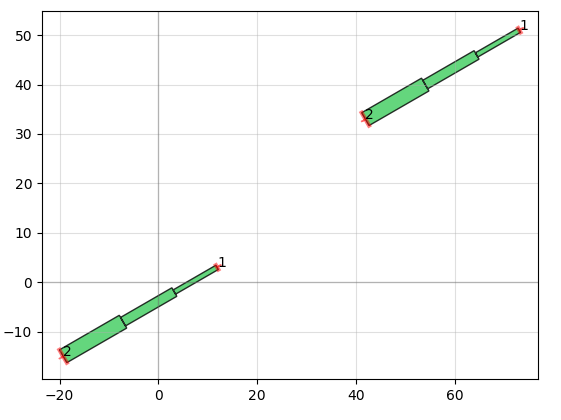

Other useful functionality available are standard operations like booleans:
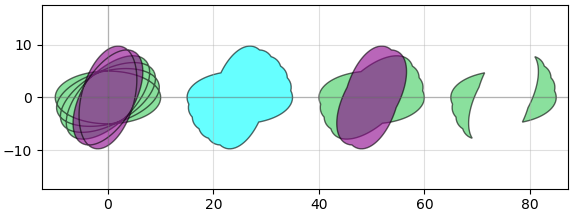
and less standard ones like creating outlines. A whole layout can be outlined directly in the GDS without requiring you to use Beamer (useful for positive-tone resist structures):
`pg.outline(D, distance = 0.7, layer = 4)`
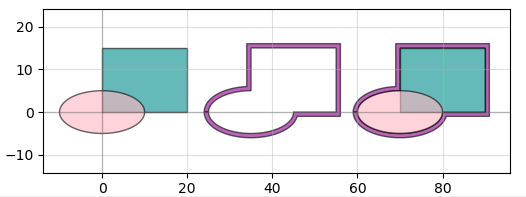
The geometry library also has useful resolution test-structures built into it, for instance
```
pg.litho_calipers(num_notches = 7, offset_per_notch = 0.1)
pg.litho_steps(line_widths = [1,2,4,8,16])
pg.litho_star(num_lines = 16, line_width = 3)
```
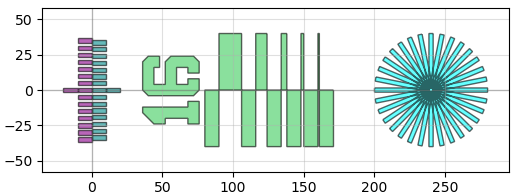
There are also handy functions to help pack shapes into as small an area as possible:
```
pg.packer(D_list, spacing = 1.25, aspect_ratio = (2,1))
```
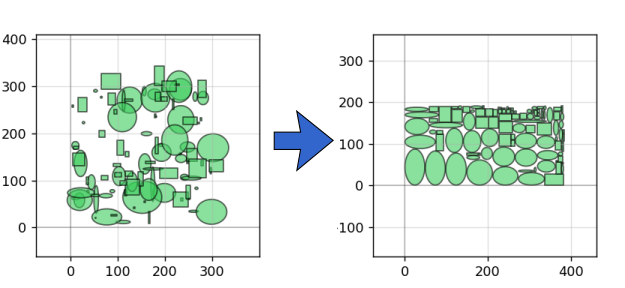
Raw data
{
"_id": null,
"home_page": null,
"name": "phidl",
"maintainer": null,
"docs_url": null,
"requires_python": null,
"maintainer_email": null,
"keywords": null,
"author": "Adam McCaughan",
"author_email": "amccaugh@gmail.com",
"download_url": "https://files.pythonhosted.org/packages/f5/64/b2539abb85dbbe4b3ec032d8356c92dd2824861c53781097528be74a82ec/phidl-1.7.2.tar.gz",
"platform": null,
"description": "[](https://github.com/amccaugh/phidl/actions/workflows/pytest.yml)\n[](https://github.com/amccaugh/phidl/actions/workflows/pre-commit.yml)\n\n# PHIDL\nGDS scripting for Python that's intuitive, fast, and powerful.\n\n- [**Installation / requirements**](#installation--requirements)\n- [**Tutorial + examples**](https://phidl.readthedocs.io/en/latest/tutorials.html) (or [try an interactive notebook](https://mybinder.org/v2/gh/amccaugh/phidl/master?filepath=phidl_tutorial_example.ipynb))\n- [**Geometry library + function documentation**](https://phidl.readthedocs.io/en/latest/geometry_reference.html)\n- [Changelog](https://github.com/amccaugh/phidl/blob/master/CHANGELOG.md) (latest update 1.7.2 on July 3, 2024)\n - New KLayout-based boolean/offset/outline functions! These are under the name `pg.kl_boolean()`, `pg.kl_offset`, `pg.kl_outline()`, `pg.kl_invert()`. They utilize the excellent KLayout tile processor, which allows breaking down & parallelizing these operations--in a nutshell, these operations should be much, much faster, and they also are more robust than the gdspy/clipper implementation. To use these new functions, you must first `pip install klayout`\n - Path.interpolate() now allows easy placement of objects alongside a path (e.g. for placing vias). See [the tutorial](https://phidl.readthedocs.io/en/latest/tutorials/waveguides.html#Interpolating-/-placing-objects-along-a-path) for more information\n\n\n# Citation\n\nIf you found PHIDL useful, please consider citing it in (just one!) of your publications -- we appreciate it greatly. ([BibTeX](https://raw.githubusercontent.com/amccaugh/phidl/master/CITATION.bib))\n - McCaughan, A. N., et. al. PHIDL: Python-based layout and geometry creation for nanolithography. *J. Vac. Sci. Technol. B* 39, 062601 (2021). http://dx.doi.org/10.1116/6.0001203\n\n# Gallery\n\n<img src=\"https://amccaugh.github.io/phidl/phidl1.png\" width=\"30%\"></img> <img src=\"https://amccaugh.github.io/phidl/phidl2.png\" width=\"30%\"></img> <img src=\"https://amccaugh.github.io/phidl/phidl3.png\" width=\"30%\"></img> <img src=\"https://amccaugh.github.io/phidl/phidl4.png\" width=\"30%\"></img> <img src=\"https://amccaugh.github.io/phidl/phidl5.png\" width=\"30%\"></img> <img src=\"https://amccaugh.github.io/phidl/phidl6.png\" width=\"30%\"></img> <img src=\"https://amccaugh.github.io/phidl/phidl7.png\" width=\"30%\"></img> <img src=\"https://amccaugh.github.io/phidl/phidl8.png\" width=\"30%\"></img> <img src=\"https://amccaugh.github.io/phidl/phidl9.png\" width=\"30%\"></img> <img src=\"https://amccaugh.github.io/phidl/phidl10.png\" width=\"30%\"></img> <img src=\"https://amccaugh.github.io/phidl/phidl11.png\" width=\"30%\"></img> <img src=\"https://amccaugh.github.io/phidl/phidl12.png\" width=\"30%\"></img>\n\n# Installation / requirements\n- Install or upgrade with `pip install -U phidl`\n- Install with `pip install -U phidl[all]` to include optional dependencies (e.g. freetype-py, klayout, rectpack)\n- Python version >=3.6\n\n## Testing\n- Install with test dependencies with `pip install -U phidl[test]` (includes `all` extras as well)\n- Run tests with `pytest` (or `python -m pytest`)\n\n# About PHIDL\n\n*fiddle (verb) - /\u02c8fidl/ - to make minor manual movements, especially to adjust something*\n\nPHIDL is an open-source GDS-based CAD tool for Python that significantly extends the excellent [gdspy](https://github.com/heitzmann/gdspy). The base installation includes a large library of simple shapes (e.g. rectangles, circles), photonic structures (e.g. sine curve waveguides), and superconducting nanowire shapes (e.g. single photon detectors) that are fully parameterized. It also has a built-in quick-plotting function based on matplotlib (or Qt) that allows you view the state of any GDS object, useful when scripting geometry-making functions. It also has a [__geometry library reference__](https://phidl.readthedocs.io/) and a set of [__very thorough tutorials__](https://phidl.readthedocs.io/en/latest/tutorials.html) that will walk you through the process of getting acquainted with PHIDL.\n\nThe goal is to bring the usability of Illustrator / Inkscape drawing programs to the GDS scripting world. Like Python itself, it aims to be readable, and intuitive. For instance, when building a geometry you don't have to worry about what the exact coordinates are anymore. If you want to separate two ellipses in the x direction by 5 units, you can do things like this:\n\n`ellipse1.xmin = ellipse2.xmax + 5`\n\nor if you want to move then rotate one ellipse by 45 degrees you can do\n\n`ellipse2.move([1,7]).rotate(45)`\n\nThere's a few dozen shortcuts like this that make life easier built into PHIDL--they're simple, but they make a world of difference when you just want to e.g. space a ring resonator some distance from a waveguide without having to track each and every coordinate of the shape.\n\n[](http://amccaugh.github.io/phidl)\n\n\n\n\nThere's also a \"port\" functionality that allows you to snap together geometry like Legos without caring about where exactly the absolute coordinates of either geometry is. For instance, connecting the above misaligned rectangles is a two-line command:\n\n\n\nIt also allows you to do things like add text and create smooth or straight routing curves between \"ports\" of different devices, convenient for making electrical or optical connections:\n\n\n\n\n\nOther useful functionality available are standard operations like booleans:\n\n\n\n and less standard ones like creating outlines. A whole layout can be outlined directly in the GDS without requiring you to use Beamer (useful for positive-tone resist structures):\n\n`pg.outline(D, distance = 0.7, layer = 4)`\n\n\n\nThe geometry library also has useful resolution test-structures built into it, for instance\n\n```\npg.litho_calipers(num_notches = 7, offset_per_notch = 0.1)\npg.litho_steps(line_widths = [1,2,4,8,16])\npg.litho_star(num_lines = 16, line_width = 3)\n```\n\n\n\nThere are also handy functions to help pack shapes into as small an area as possible:\n\n```\npg.packer(D_list, spacing = 1.25, aspect_ratio = (2,1))\n```\n\n\n",
"bugtrack_url": null,
"license": null,
"summary": "PHIDL",
"version": "1.7.2",
"project_urls": null,
"split_keywords": [],
"urls": [
{
"comment_text": "",
"digests": {
"blake2b_256": "f564b2539abb85dbbe4b3ec032d8356c92dd2824861c53781097528be74a82ec",
"md5": "faafc83b5df74b58948078872dbb7467",
"sha256": "9cda9fdf52035b11b27ab58e165bd627ebabe8f5f4d1c6764861830c36cf7896"
},
"downloads": -1,
"filename": "phidl-1.7.2.tar.gz",
"has_sig": false,
"md5_digest": "faafc83b5df74b58948078872dbb7467",
"packagetype": "sdist",
"python_version": "source",
"requires_python": null,
"size": 109412,
"upload_time": "2024-07-03T14:31:52",
"upload_time_iso_8601": "2024-07-03T14:31:52.784730Z",
"url": "https://files.pythonhosted.org/packages/f5/64/b2539abb85dbbe4b3ec032d8356c92dd2824861c53781097528be74a82ec/phidl-1.7.2.tar.gz",
"yanked": false,
"yanked_reason": null
}
],
"upload_time": "2024-07-03 14:31:52",
"github": false,
"gitlab": false,
"bitbucket": false,
"codeberg": false,
"lcname": "phidl"
}